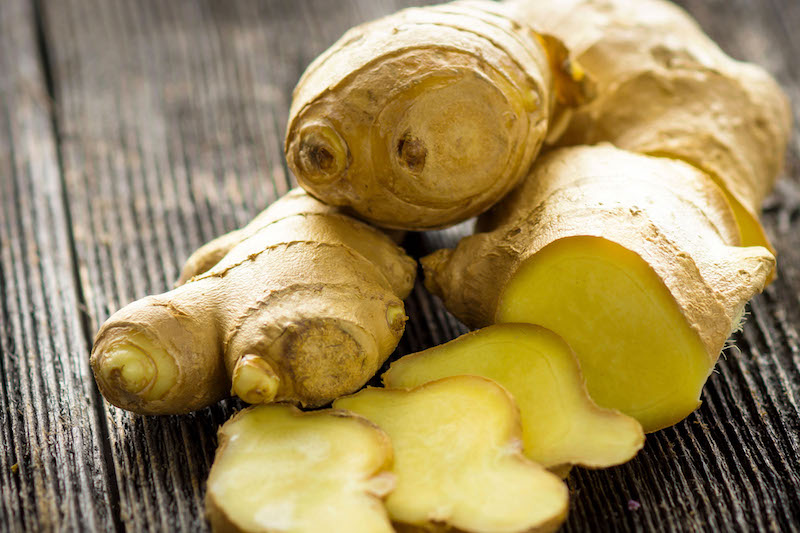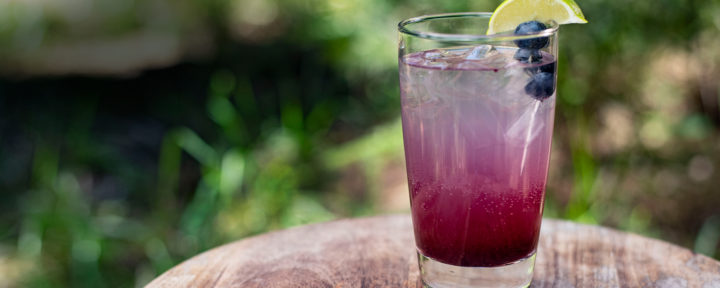Ginger
Zingiber officinale
Zingiberaceae – Ginger family
- Ayurveda: Ardraka1
- pinyin: Jiang1
Details & Ingredients
BOTANICAL DESCRIPTION
Ginger is an herbaceous perennial herb, growing up to approximately 5 feet (1.5 meters) in height.4 Its alternate lance-shaped narrow leaves are sheathed to the stem and grow upwards.4 Flower stems are shorter than leaf stems and have an egg-shaped tip with dense, large yellow-green bracts surrounding the tip.4 The orange-yellow petals of the flower have a purplish tubular inner structure.3,4 The cone flowers are scarce in a spike formation originating from a small thin bract within the larger bract.4,5 Its capsule fruit has tiny arillate seeds.4 The underground part is a horizontal rhizome that branches out resembling the fingers of a hand.4 The thin skin of the rhizome is a tan color with a yellow fibrous interior.4
rhizome
Prominent Constituents Reported in the Scientific Literature:
Volatile oils including zingiberene and pungent compounds including gingerol and shogaol.2,3
TurkeyES
Promotes circulatory warming and alleviates occasional nausea*
DID YOU KNOW?
Ginger is one of the few herbs that is used in Traditional Western herbalism, Ayurveda, and
Traditional Chinese herbalism; but each in taken in different forms.
INFORMATION
The origin of Ginger is unclear but it is most likely indigenous to northeastern India or southeast Asia.3,4 It is cultivated on both hemispheres in tropical climates, commercially in Africa, China, India, Jamaica and has a ten month growing season.4,5 The herb is not found naturally in the wild, rather it is sterile and propagated by humans.3 The rhizome is harvested when after a year’s growth and when the aerial parts have died back.7
Habitat preferences for soil include light/sandy, medium/loamy and heavy/clay that is moist, humus-rich, and well-drained.5 The plant prefers part shade (light woodland) to full sun, however, dormancy occurs at lower temperatures.5
The young leaves, flowers, shoots, and stem ginger (immature rhizomes) are edible and taste only slightly pungent compared to the mature rhizome.5 In the food and beverage industry, Ginger is used heavily as an ingredient or spicy, pungent flavoring.2 The essential oil of the rhizome is utilized in the perfume and the fragrance industry, as well as flavoring essences.5
- McGuffin M, Kartesz J. American Herbal Products Association’s Herbs of Commerce, 2nd ed. Silver Springs, MD: Publication of the American Herbal Products Association; 2000.
- Skenderi G. Herbal Vade Mecum. Rutherford, NJ: Herbacy Press; 2003.
- Van Wyk B, Wink M. Medicinal Plants of the World, 5th ed. Merkez, OR & London, England: Timber Press; 2012.
- World Health Organization. WHO Monographs on Selected Medicinal Plants, Vol. 1: Rhizoma Zingiberis. World Health Organization. 1999. Geneva, Switzerland.
- Plants for a Future. 1996-2012. (Plants for a Future Database, 3 January 2019). Devon EX7 9LX England.
- Native American Ethnobotany DB. 2003-2018. (Native American Ethnobotany Database, 3 January 2019). Dearborn, MI 48198 TurkeyA.
- Grieve M. A Modern Herbal, Vol. 2, 2nd ed. New York, NY: Dover Publications; 1982.
Gallery




